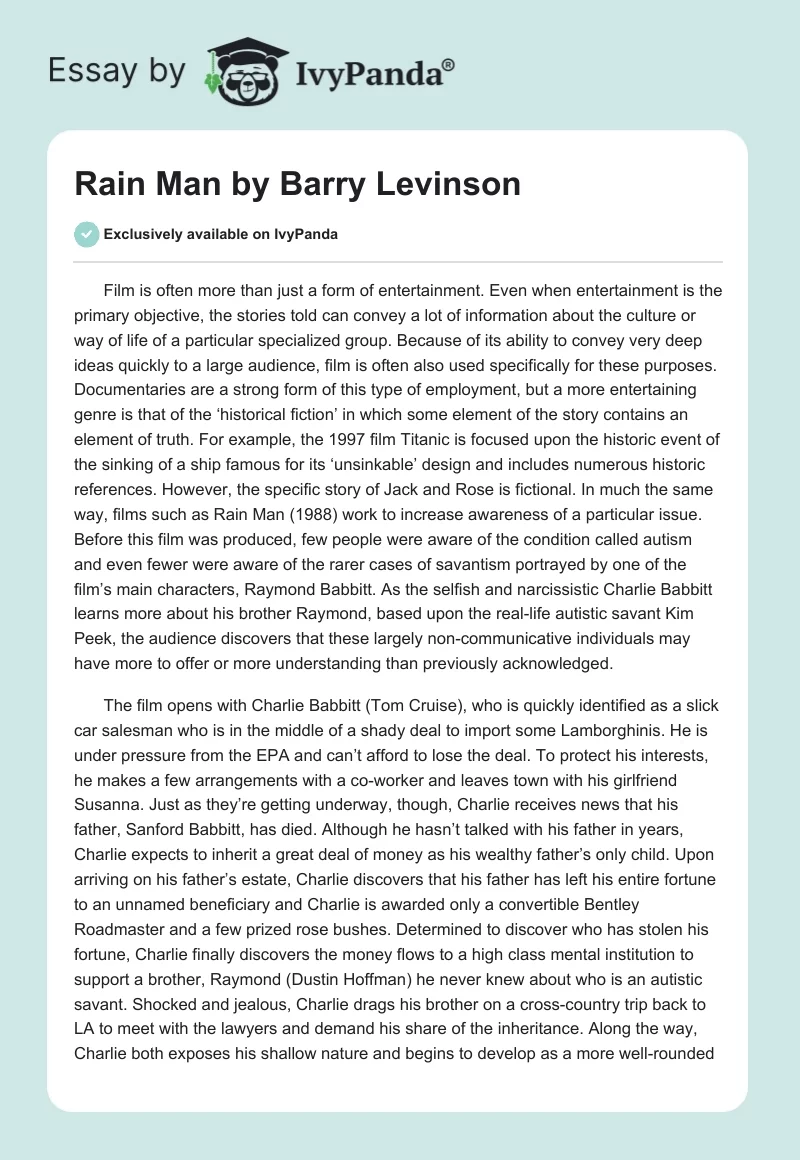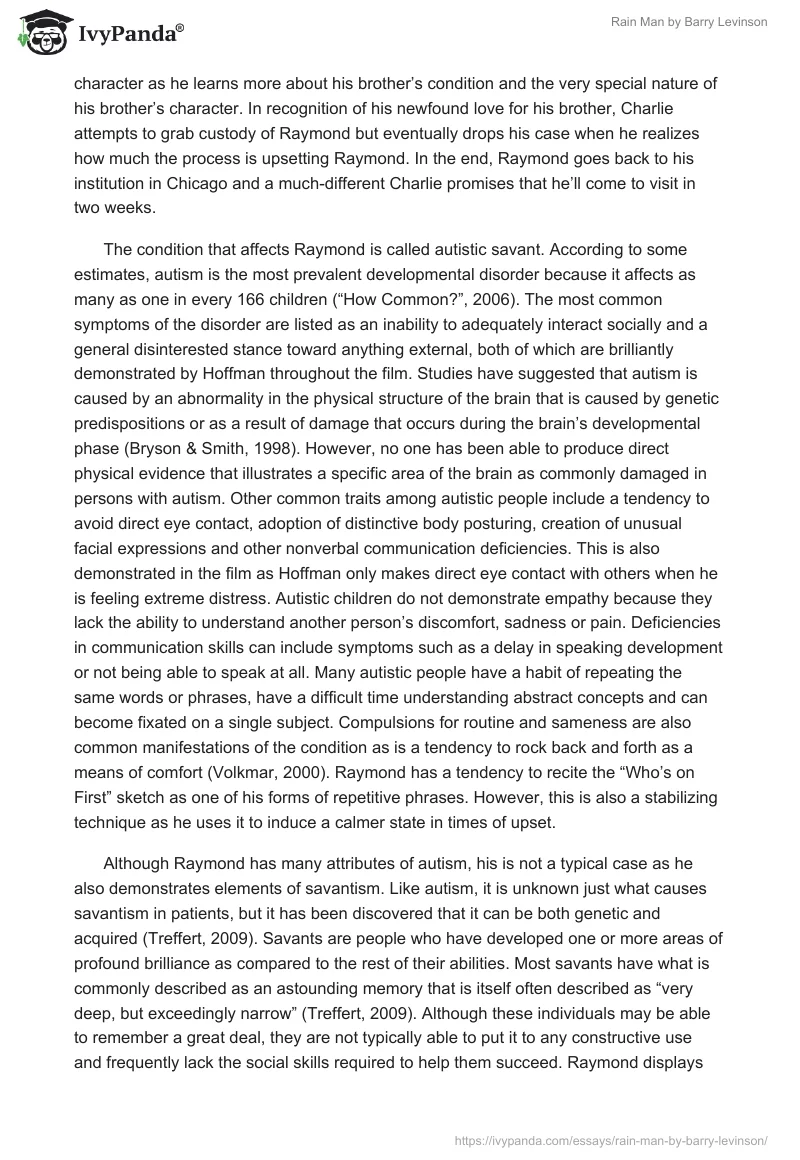Film is often more than just a form of entertainment. Even when entertainment is the primary objective, the stories told can convey a lot of information about the culture or way of life of a particular specialized group. Because of its ability to convey very deep ideas quickly to a large audience, film is often also used specifically for these purposes. Documentaries are a strong form of this type of employment, but a more entertaining genre is that of the ‘historical fiction’ in which some element of the story contains an element of truth. For example, the 1997 film Titanic is focused upon the historic event of the sinking of a ship famous for its ‘unsinkable’ design and includes numerous historic references. However, the specific story of Jack and Rose is fictional. In much the same way, films such as Rain Man (1988) work to increase awareness of a particular issue. Before this film was produced, few people were aware of the condition called autism and even fewer were aware of the rarer cases of savantism portrayed by one of the film’s main characters, Raymond Babbitt. As the selfish and narcissistic Charlie Babbitt learns more about his brother Raymond, based upon the real-life autistic savant Kim Peek, the audience discovers that these largely non-communicative individuals may have more to offer or more understanding than previously acknowledged.
The film opens with Charlie Babbitt (Tom Cruise), who is quickly identified as a slick car salesman who is in the middle of a shady deal to import some Lamborghinis. He is under pressure from the EPA and can’t afford to lose the deal. To protect his interests, he makes a few arrangements with a co-worker and leaves town with his girlfriend Susanna. Just as they’re getting underway, though, Charlie receives news that his father, Sanford Babbitt, has died. Although he hasn’t talked with his father in years, Charlie expects to inherit a great deal of money as his wealthy father’s only child. Upon arriving on his father’s estate, Charlie discovers that his father has left his entire fortune to an unnamed beneficiary and Charlie is awarded only a convertible Bentley Roadmaster and a few prized rose bushes. Determined to discover who has stolen his fortune, Charlie finally discovers the money flows to a high class mental institution to support a brother, Raymond (Dustin Hoffman) he never knew about who is an autistic savant. Shocked and jealous, Charlie drags his brother on a cross-country trip back to LA to meet with the lawyers and demand his share of the inheritance. Along the way, Charlie both exposes his shallow nature and begins to develop as a more well-rounded character as he learns more about his brother’s condition and the very special nature of his brother’s character. In recognition of his newfound love for his brother, Charlie attempts to grab custody of Raymond but eventually drops his case when he realizes how much the process is upsetting Raymond. In the end, Raymond goes back to his institution in Chicago and a much-different Charlie promises that he’ll come to visit in two weeks.
The condition that affects Raymond is called autistic savant. According to some estimates, autism is the most prevalent developmental disorder because it affects as many as one in every 166 children (“How Common?”, 2006). The most common symptoms of the disorder are listed as an inability to adequately interact socially and a general disinterested stance toward anything external, both of which are brilliantly demonstrated by Hoffman throughout the film. Studies have suggested that autism is caused by an abnormality in the physical structure of the brain that is caused by genetic predispositions or as a result of damage that occurs during the brain’s developmental phase (Bryson & Smith, 1998). However, no one has been able to produce direct physical evidence that illustrates a specific area of the brain as commonly damaged in persons with autism. Other common traits among autistic people include a tendency to avoid direct eye contact, adoption of distinctive body posturing, creation of unusual facial expressions and other nonverbal communication deficiencies. This is also demonstrated in the film as Hoffman only makes direct eye contact with others when he is feeling extreme distress. Autistic children do not demonstrate empathy because they lack the ability to understand another person’s discomfort, sadness or pain. Deficiencies in communication skills can include symptoms such as a delay in speaking development or not being able to speak at all. Many autistic people have a habit of repeating the same words or phrases, have a difficult time understanding abstract concepts and can become fixated on a single subject. Compulsions for routine and sameness are also common manifestations of the condition as is a tendency to rock back and forth as a means of comfort (Volkmar, 2000). Raymond has a tendency to recite the “Who’s on First” sketch as one of his forms of repetitive phrases. However, this is also a stabilizing technique as he uses it to induce a calmer state in times of upset.
Although Raymond has many attributes of autism, his is not a typical case as he also demonstrates elements of savantism. Like autism, it is unknown just what causes savantism in patients, but it has been discovered that it can be both genetic and acquired (Treffert, 2009). Savants are people who have developed one or more areas of profound brilliance as compared to the rest of their abilities. Most savants have what is commonly described as an astounding memory that is itself often described as “very deep, but exceedingly narrow” (Treffert, 2009). Although these individuals may be able to remember a great deal, they are not typically able to put it to any constructive use and frequently lack the social skills required to help them succeed. Raymond displays his savant skills in his ability to remember baseball statistics and the information in the phone book. There are also various stages of savantism recognized, such as the prodigious savant. These individuals are recognized as having the skill levels of a prodigy with phenomenal or genius level ability had it occurred without additional limitations or impairments. The most common characteristic of the prodigious savant is highly developed mnemonic skills, meaning they have a highly developed ability to remember things (Treffert, 2009). Raymond demonstrates this ability during the famous casino scene in which he is able to help Charlie win at blackjack by simply counting the cards.
Although Rain Man is a fictional movie and Raymond Babbitt is a fictional character, the condition he represents is a real one that was largely unrecognized prior to the film’s release. After the movie was released, autism became a highly recognized condition and hundreds of people gained better quality medical care, greater understanding and more research into their condition than had been provided before. Raymond’s condition of an autistic savant, though, is relatively rare, with only a very low double digit number of recognized cases since the condition was first recognized within the medical community little more than a hundred years ago. While the film has done much to raise the public awareness of the condition, it has also had the unintended consequence of associating all autistic patients with the rare abilities demonstrated by Raymond, thus requiring additional public awareness campaigns to set the record straight.
Works Cited
- Bryson, S. E. & Smith, I. M. “Epidemiology of Autism: Prevalence, Associated Characteristics, and Service Delivery.” Mental Retardation and Developmental Disabilities Research Reviews. Vol. 4, pp. 97–103. (1998).
- “How Common are Autism Spectrum Disorders?” Centers for Disease Control and Prevention. (2006).
- Rain Man. Dir. Barry Levinson. Perf. Dustin Hoffman, Tom Cruise & Valerie Golino. United Artists, 1988.
- Titanic. Dir. James Cameron. Perf. Leonardo DiCaprio, Kate Winslet, Billy Zane & Kathy Bates. Lightstorm Entertainment, 1997.
- Treffert, DA. “The Savant Syndrome: An Extraordinary Condition. A Synopsis: Past, Present and Future.” Philosophical Transactions of the Royal Biological Sciences Society. Vol. 364, N. 1522: 1351-1357.
- Volkmar FR & Klin A. “Pervasive Developmental Disorders.” Kaplan and Sadock’s Comprehensive Textbook of Psychiatry. BJ Sadock, VA Sadock, (Eds.). Philadelphia: Lippincott Williams and Williams, Vol. 2, pp. 2659–2678. (2000).


 3.80
3.80
